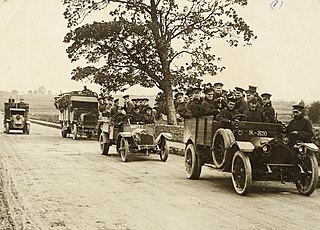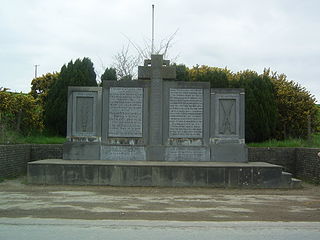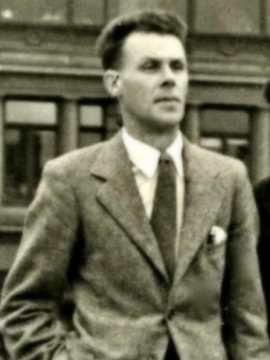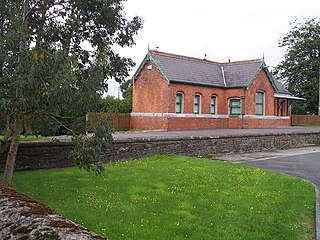
The Irish War of Independence or Anglo-Irish War was a guerrilla war fought in Ireland from 1919 to 1921 between the Irish Republican Army and British forces: the British Army, along with the quasi-military Royal Irish Constabulary (RIC) and its paramilitary forces the Auxiliaries and Ulster Special Constabulary (USC). It was part of the Irish revolutionary period.

Tramore is a seaside town in County Waterford, on the southeast coast of Ireland. It has a population of 11,277 as per the 2022 census, the second largest town in the county.

This is a timeline of the Irish War of Independence of 1919–21. The Irish War of Independence was a guerrilla conflict and most of the fighting was conducted on a small scale by the standards of conventional warfare.

The Crossbarry ambush or Battle of Crossbarry occurred on 19 March 1921 and was one of the largest engagements of the Irish War of Independence. It took place near the small village of Crossbarry in County Cork, about 20 km south-west of Cork city. About a hundred Irish Republican Army (IRA) volunteers, commanded by Tom Barry, escaped an attempt by about 1,200 British troops to encircle them. During the hour-long battle, ten British troops and three IRA volunteers were killed.
Charles Hurley was Officer Commanding of the 3rd Cork Brigade of the Irish Republican Army during the Irish War of Independence (1919–1921)
This is a timeline of the Irish Civil War, which took place between June 1922 and May 1923. It followed the Irish War of Independence (1919–1921), and accompanied the establishment of the Irish Free State as an entity independent from the United Kingdom of Great Britain and Ireland.
The Coolavokig ambush was carried out by the Irish Republican Army (IRA) on 25 February 1921, during the Irish War of Independence. It took place at Coolavokig, on the road between Macroom and Ballyvourney, County Cork. A 60-man flying column of the IRA's 1st Cork Brigade under Seán O'Hegarty, ambushed a 70-man convoy of the Auxiliary Division under Major Seafield Grant, sparking a four-hour battle. Ten Auxiliaries were killed, including Major Grant, and others wounded. The IRA column left the area when British reinforcements arrived. After the ambush, British forces stopped carrying out raids and patrols in the area.
The Scramoge ambush was an ambush carried out by the Irish Republican Army (IRA) on 23 March 1921, during the Irish War of Independence. The IRA ambushed a lorry carrying British troops and Royal Irish Constabulary (RIC) officers at Scramoge, near Strokestown in County Roscommon. Three British soldiers and an RIC officer were killed, while two RIC 'Black and Tans' were captured and shot dead shortly after.
The Selton Hill ambush took place on 11 March 1921, during the Irish War of Independence. An Irish Republican Army (IRA) flying column was ambushed by members of the RIC Auxiliary Division at Selton Hill, County Leitrim. Six IRA members of the South Leitrim Brigade were killed, which effectively destroyed the IRA in South Leitrim.
The Sheemore ambush was an ambush carried out by the Irish Republican Army (IRA) on 4 March 1921, during the Irish War of Independence. It took place at Sheemore near Carrick-on-Shannon, County Leitrim.
The Burgery ambush was an ambush carried out by the Irish Republican Army (IRA) on 18–19 March 1921, during the Irish War of Independence. It took place near Dungarvan, County Waterford.

Michael Kilroy was an Irish republican and politician. He was an Irish Republican Army (IRA) officer in his native County Mayo during the Irish War of Independence and Irish Civil War. Subsequently, he was a Sinn Féin and later Fianna Fáil Teachta Dála (TD) for Mayo South.

The Headford ambush was carried out by the Irish Republican Army (IRA) on 21 March 1921, during the Irish War of Independence. The IRA's 2nd Kerry Brigade ambushed a train carrying British troops of the Royal Fusiliers at Headford Junction railway station near Killarney, County Kerry. This sparked a battle lasting almost an hour, in which at least 13 people were killed – eight British soldiers, two IRA volunteers and three civilians. The IRA withdrew after another train carrying British troops arrived.
The Tooreen ambush was an ambush carried out by the Irish Republican Army (IRA) on 22 October 1920, during the Irish War of Independence. It took place near Roberts Farm, Tooreen, near Ballinhassig in County Cork. The IRA ambushed two lorries of British soldiers, killing three and wounding four others. The British surrendered and their weapons and ammunition were seized by the IRA. Later that night, British soldiers went on a rampage in nearby Bandon.

George Lennon was an Irish Republican Army leader during the Irish War of Independence and the Irish Civil War.
The Clonmult ambush took place on 20 February 1921, during the Irish War of Independence.

The Upton train ambush took place on 15 February 1921, during the Irish War of Independence. The Irish Republican Army (IRA) mounted an attack on a train carrying British soldiers at Upton, County Cork. The action was a disaster for the IRA; three of its volunteers were killed, two wounded and one captured. Six British soldiers were wounded, three seriously. At least eight civilian passengers were killed and ten wounded in the crossfire.
The Piltown Cross ambush was an action of the Irish Republican Army (IRA) during the Irish War of Independence. The attack on British forces took place on the night of 1 November 1920 near the small town of Kinsalebeg, County Waterford. The site of the attack at the crossroads known as Piltown Cross was carefully chosen to give the attackers maximum tactical advantage.
The Kilmeena ambush was an action during the Irish War of Independence that took place at Kilmeena, County Mayo on 19 May 1921. The ambush ended in defeat for the local West Mayo Irish Republican Army (IRA), with five IRA volunteers killed and four wounded and captured. Two members of the Royal Irish Constabulary (RIC) and one Black and Tan were also killed in the action.

George Oliver Plunkett, known to his contemporaries as Seoirse Plunkett, was a militant Irish republican. He was sentenced to death with his elder brother Joseph Plunkett and his younger brother John after the 1916 Easter Rising, but while Joseph was executed, George's and John's sentences were commuted. He was released in 1917, fought in the Irish War of Independence and Irish Civil War, and was briefly IRA Chief of Staff during World War II.








